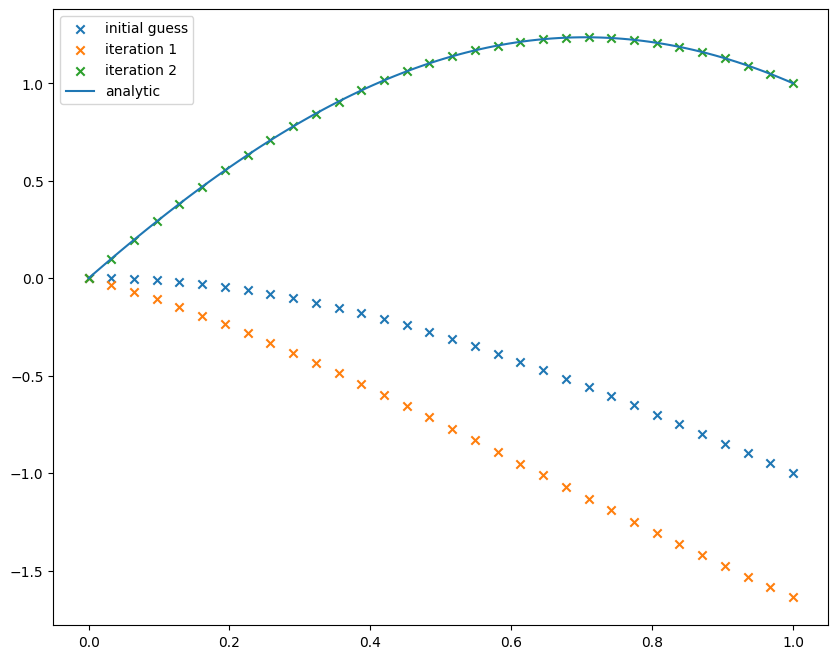Two Point Boundary Value Problems
import numpy as np
import matplotlib.pyplot as plt
import matplotlib as mpl
mpl.rcParams['figure.dpi'] = 100
mpl.rcParams['figure.figsize'] = (10, 8)
Two Point Boundary Value Problems#
Consider a Poisson equation:
on \([0, 1]\). This is a second-order ODE, so it requires 2 boundary conditions. Let’s take:
These are at opposite ends on the domain—this is not an initial value problem. The methods we used thus far do not work on this.
Later we’ll see how to apply relaxation methods to this problem. Now we’ll consider shooting.
Let’s rewrite this as a system:
Let’s take the left boundary conditions as:
What is \(\eta\)? This is a parameter that we will adjust to make the solution yield \(y(1) = b\) at the end of integration. We’ll all the solution for a particular value of \(\eta\) \(y^{(\eta)}(x)\).
Shooting algorithm:
Guess \(\eta\)
Iterate:
Integrate system to right boundary
Use secant method to zero \(f(\eta) = b - y_1^{(\eta)}(1)\)
Correct \(\eta\)
Example (from Pang):
with
This has the analytic solution:
Here’s an implementation that uses RK4.
First the RHS function:
def rhs(y1, y2):
""" RHS function. Here y1 = u, y2 = u'
This means that our original system is:
y2' = u'' = -0.25*pi**2 (u+1) """
dy1dx = y2
dy2dx = -0.25*np.pi**2 * (y1 + 1.0)
return dy1dx, dy2dx
Now the integrator:
def rk4(y_init, rhs, xl=0.0, xr=1.0, n=100):
"""
R-K 4 integration: y1_0 and eta are y1(0) and y2(0) rhs is the
righthand side function xl and xr are the domain limits n
is the number of integration points (including starting point)
"""
# compute the step size
h = (xr - xl)/(n-1)
y1 = np.zeros(n)
y2 = np.zeros(n)
# left boundary initialization
y1[0] = y_init[0]
y2[0] = y_init[1]
for m in range(n-1):
dy1dx_1, dy2dx_1 = rhs(y1[m], y2[m])
dy1dx_2, dy2dx_2 = rhs(y1[m] + 0.5*h*dy1dx_1, y2[m] + 0.5*h*dy2dx_1)
dy1dx_3, dy2dx_3 = rhs(y1[m] + 0.5*h*dy1dx_2, y2[m] + 0.5*h*dy2dx_2)
dy1dx_4, dy2dx_4 = rhs(y1[m] + h*dy1dx_3, y2[m] + h*dy2dx_3)
y1[m+1] = y1[m] + (h/6.0)*(dy1dx_1 + 2.0*dy1dx_2 + 2.0*dy1dx_3 + dy1dx_4)
y2[m+1] = y2[m] + (h/6.0)*(dy2dx_1 + 2.0*dy2dx_2 + 2.0*dy2dx_3 + dy2dx_4)
return y1, y2
and finally the driver:
def solve_bvp(ax=None):
"""shoot from x = 0 to x = 1. We will do this by selecting a boundary
value for y2 and use a secant method to adjust it until we reach the
desired boundary condition at y1(1)"""
# domain size
x_left = 0.0
x_right = 1.0
# desired right BC, y1(1)
y1_right_true = 1.0
# number of integration points
npts = 32
# desired tolerance
eps = 1.e-8
# initial guess
y1_0 = 0.0 # this is the correct boundary condition a x = 0
eta = 0.0 # this is what we will adjust to get the desired y1(1)
# integrate
y1_old, y2_old = rk4([y1_0, eta], rhs, xl=0.0, xr=1.0, n=npts)
if ax:
x = np.linspace(0.0, 1.0, npts)
ax.scatter(x, y1_old, label="initial guess", marker="x")
# new guess -- we don't have any info on how to compute this yet, so
# just choose something
eta_m1 = eta # store the old guess
eta = -1.0
# Secant loop
dy = 1000.0 # fail first time through
# keep track of iteration for plotting
iter = 1
while dy > eps:
# integrate
y1, y2 = rk4([y1_0, eta], rhs, xl = 0.0, xr = 1.0, n=npts)
if ax:
ax.scatter(x, y1, label=f"iteration {iter}", marker="x")
# do a Secant method to correct. Here eta = y2(0) -- our
# control parameter. We want to zero:
# f(eta) = y1_true(1) - y1^(eta)(1)
# derivative (for Secant)
dfdeta = ( (y1_right_true - y1_old[-1]) -
(y1_right_true - y1[-1]) ) / (eta_m1 - eta)
# correction by f(eta) = 0 = f(eta_0) + dfdeta deta
deta = -(y1_right_true - y1[-1]) / dfdeta
# store the old guess and correct
eta_m1 = eta
eta += deta
dy = abs(deta)
y1_old = y1
y2_old = y2
iter += 1
return eta, y1, y2
Now we’ll run it, making plots along the way. We’ll also show the analytic solution
def analytic(x):
""" analytic solution """
return np.cos(np.pi*x/2) + 2.0*np.sin(np.pi*x/2) - 1.0
fig = plt.figure()
ax = fig.add_subplot(111)
eta, y1, y2 = solve_bvp(ax)
x = np.linspace(0, 1, 100)
ax.plot(x, analytic(x), label="analytic")
ax.legend()
<matplotlib.legend.Legend at 0x7f57604493f0>

References:
Pang
Neumann


